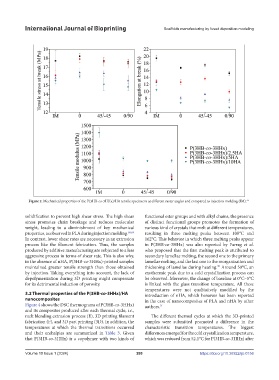Page 288 - IJB-10-1
P. 288
International Journal of Bioprinting Scaffolds manufacturing by fused deposition modeling
Figure 2. Mechanical properties of the P(3HB-co-3HHx)/HA tensile specimens at different raster angles and compared to injection molding (IM). 58
solidification to prevent high shear stress. The high shear functional ester groups and with alkyl chains, the presence
stress promotes chain breakage and reduces molecular of distinct functional groups promotes the formation of
weight, leading to a diminishment of key mechanical various kind of crystals that melt at different temperatures,
properties, as observed in PLA during injection molding. 68,69 resulting in three melting peaks between 108°C and
In contrast, lower shear rates are necessary in an extrusion 162°C. This behavior in which three melting peaks appear
process like the filament fabrication. Thus, the samples in P(3HB-co-3HHx) was also reported by Farrag et al.
produced by additive manufacturing are subjected to a less who proposed that the first melting peak is attributed to
aggressive process in terms of shear rate. This is also why, secondary lamellae melting, the second one to the primary
in the absence of nHA, P(3HB-co-3HHx)-printed samples lamellae melting, and the last one to the reorganization and
maintained greater tensile strength than those obtained thickening of lamellae during heating. Around 50°C, an
70
by injection. Taking everything into account, the lack of exothermic peak due to a cold crystallization process can
depolymerization during 3D printing might compensate be observed. Moreover, the change of baseline at 0°C–5°C
for its detrimental induction of porosity. is linked with the glass transition temperature. All these
temperatures were not qualitatively modified by the
3.2 Thermal properties of the P(3HB-co-3HHx)/HA introduction of nHA, which however has been reported
nanocomposites in the case of nanocomposites of PLA and nHA by other
Figure 4 shows the DSC thermograms of P(3HB-co-3HHx) authors. 71
and its composites produced after each thermal cycle, i.e.,
melt blending extrusion process (E), 3D printing filament The different thermal cycles at which the 3D-printed
fabrication (F), and 3D part printing (3D). In addition, the samples were submitted promoted a difference in the
temperatures at which the thermal transitions occurred characteristic transition temperatures. The biggest
and their enthalpies are summarized in Table 3. Given differences emerged for the cold crystallization temperature,
that P(3HB-co-3HHx) is a copolymer with two kinds of which was reduced from 52.1°C for P(3HB-co-3HHx) after
Volume 10 Issue 1 (2024) 280 https://doi.org/10.36922/ijb.0156

